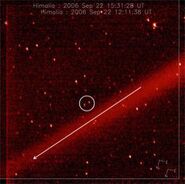Please cite reliable and peer reviewed sources, that are not your brain. Unsourced material may be removed or deleted.
Himalia is a large, prograde, non-spherical irregular orbiting the planet of Jupiter. Himalia is the largest of the irregular satellites belonging to Jupiter. It was discovered on December 3, 1904 by Charles Dillon Perrine at the Lick Observatory. Due to its size and its brightness, Himalia is the easiest observed irregular satellite of Jupiter. In fact, it is so large and massive, the only moons of Jupiter larger than Himalia are the four Galilean moons and Amalthea. Although it is brighter in apparent magnitude and bigger, Amalthea, is close to Jupiter, therefore being less easily observed by the human eye. Although smaller, Himalia is more massive than Amalthea.
Formation[]
Himalia was likely formed as an asteroid in the asteroid belt. It was then captured by Jupiter’s gravity as a result of getting too close to the planet.
Naming[]
Himalia was named after Himalia, the nymph that bore three sons from Zeus. In the 1950's and 1970's, people mistook the name Himalia for Hestia, a Greek goddess.
Composition[]
Like many other moons belonging to Jupiter, water is thought to be present inside of the layers of Himalia, sandwiched between two layers.
Surface[]
The surface of Himalia appears to be gray and has other spectra of color that match that of a C-type asteroid. There are no visible mountainous areas or valleys, common in Himalia grouped satellites. The only visible mountainous areas are under the surface in the lower crust. It is believed that these mountains will soon be pushed to the surface in the next million years.
Exploration[]
In 2000, Himalia was photographed by the Cassini spacecraft. Only though the images were a few pixels in length and height, the images can show the axes of the moon match that of Earth-based measurements. The image was taken from five million miles away.
Himalia Ring[]
Main article: Himalia Ring





